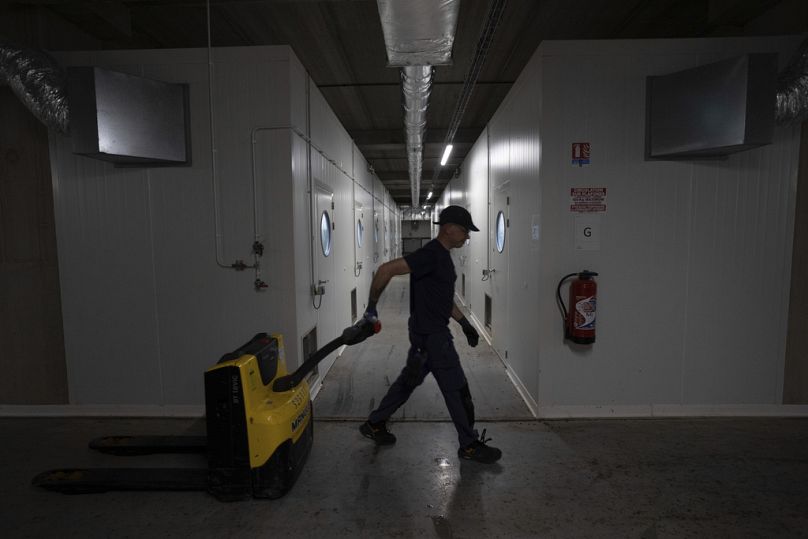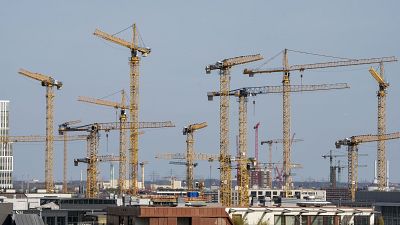December marks the seventh month of contraction for services and manufacturing in the eurozone, with the rate of decline picking up since November.
The eurozone's manufacturing and service sectors continue to shrink, against a backdrop of falling demand and climbing costs.
Hamburg Commercial Bank (HCOB) and the index provider S&P Global released a new set of data on Friday measuring the economic health of the euro area.
The four key PMI (Purchasing Managers' Index) figures look at a range of indicators across the manufacturing and service sectors, including new orders, output, employment, suppliers’ delivery times, and inventories.
Composite PMI Output Index, which is a weighted average that looks at output between the two sectors, came in at 47 for the start of December, down from 47.6 in November, and 46.5 in October.
The composite index has now remained below 50, the threshold for economic contraction, for seven months.
The Eurozone PMI study is based on survey responses from companies based in Germany, France, Italy, Spain, the Netherlands, Austria, Ireland, and Greece, yet it’s useful to note that the most recent figures are so-called 'flash' numbers.
This means they are based on 85% to 90% of the total PMI responses gathered each month, and they are used as an advanced prediction.
"Once again, the figures paint a disheartening picture as the Eurozone economy fails to display any distinct signs of recovery," said Dr Cyrus de la Rubia, chief economist at HCOB in response to the data.
"On the contrary, it has contracted for six straight months. The likelihood of the Eurozone being in a recession since the third quarter remains notably high," he added.
Short-lived easing for the manufacturing sector
The Composite Index takes into account output in the manufacturing sector and activity in the services sector.
Looking solely at manufacturing output, the index came in at 44.1.
This figure for December is down from 44.6 in November, and up from 43.1 in October, showing that November’s eased rate of contraction was a short-lived ray of hope.
Looking solely at the Services PMI Activity Index, this number came in at 48.1 in December, down from 48.7 in November.
This is the third fastest rate of decline seen since the COVID-19 lockdowns in early 2021.
Declining demand
Across the two sectors studied, new orders fell for the seventh consecutive month in December, although the rate of decline remained unchanged from November.
In the services sector, the loss of new orders remained amongst the highest seen over the past three years, and demand has now been falling for six months in a row.
New orders in the manufacturing sector have been in decline for 20 consecutive months, although the past two months have seen less dramatic drops.
Employment figures in the doldrums
To cope with weakened demand, companies have been tightening the purse strings and cutting back on staff.
In the manufacturing sector, payrolls were cut for the seventh straight month, and if the pandemic months are excluded, the rate of job losses is amongst the highest seen since 2012.
Regarding service providers, staffing levels were marginally higher in December, but the rate of hiring fell.
Climbing input costs
Input costs continued to increase across both the manufacturing and services sectors in December, but nonetheless showed the smallest monthly rise since August.
In the manufacturing industry, prices have now been falling for 10 straight months, whereas in the service sector, prices are rising at the slowest rate since July.
These figures can be explained by cooling inflation, but also by a decline in companies' purchasing activity.
Room for optimism?
Looking to the year ahead, confidence levels vary greatly between the manufacturing and service sectors, although they remain below long-term averages.
Service firms are gloomier than they have been in a year, whereas in the manufacturing sector, confidence has reached its highest level since May.
France and Germany founder while UK endures
On a national level, contractions were most severe in France, where business activity slowed at its sharpest rate since March 2013, excluding the pandemic years.
The picture from Germany was almost as alarming, as the Composite Purchasing Managers' Index fell for the sixth consecutive month, declining to 46.7 in December, down from November's figure of 47.8.
Out of the eurozone and to the UK, the picture is slightly more positive.
Whilst manufacturing output is down, leading to an increase in factory job losses, the Composite Output Index and the Services PMI Activity Index are both sitting above the 50 threshold, signalling growth.
"We had a very mixed bag of macroeconomic news out of Europe this morning," said Matthew Ryan, head of market strategy at global financial services firm Ebury.
"The Euro Area economy appears to be barrelling towards a technical recession in Q4 [...] following broad-based downturns in activity in both Germany and France," he explained.
"By contrast, the UK economy looks to be in a much healthier state, with economic activity seemingly accelerating as we approach year-end," Ryan said. "This should both quell investor concerns surrounding the possibility of a UK recession, and vindicate the Bank of England’s ‘higher for longer’ stance on interest rates."




